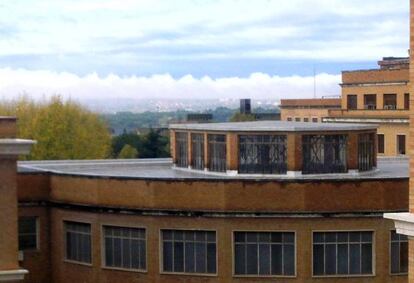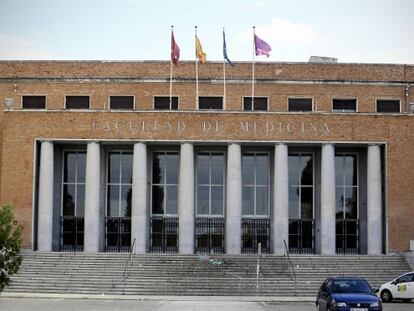Skulls, skeletons and shrimp: report lists Madrid anatomy department finds
Lecturer describes Dantesque scene found at Complutense University medical faculty


When EL PAÍS revealed on Tuesday that a mummified corpse and two skeletons had been discovered on the roof of the anatomy department at Madrid’s Complutense University, college officials offered their version of events. But a report written by a lecturer about the incident paints an altogether different picture of the macabre discovery.
The facts date back to October 29, when an anatomy lecturer discovered the body parts in a structure on the roof of the department. No one has yet offered a proper explanation as to how they came to be there, nor why they had been left up there for so long.
The Madrid university’s Anatomy II department had already hit the headlines this year, after employees reported in May that hundreds of bodies donated to science were piling up in varying states of decay inside its basement.
The door had been forced open and the parts of the lock were on a table”
The lecturer’s report on this latest incident, to which EL PAÍS has had access, describes a scene that sounds like something out of a horror film, and contradicts the university’s claim that the mummified body was in a desiccation area and protected from the elements.
“The observations I am going to make are based on the three visits that I made to the rooftop of building VI, in which the mummy was found,” the report begins. “It is not true to say that the room was used as a desiccation area, given its characteristics. […] It is also not true that the door had a lock, given that it had been forced open and the parts of the lock were on a table […].”
“On a number of the laboratory benches there were remains that had been mummified (half a head and neck attached to a shoulder, remains of human fetuses, anatomical sections …) in bags that fell apart when they were touched given the large amount of time they had been exposed to the light and the environmental conditions.” The dean’s office had claimed that the human remains found there – the mummified corpse and two skeletons – were “perfectly protected and shielded.”
Bird droppings were perfectly identifiable in a number of places”
The lecturer goes on to explain how they dealt with the mummy: “The mummified corpse was bagged up in order to grant it the dignity it was lacking, having been left on a bed of filter paper on top of a dissection table.” As for the other remains: “We placed them in a new black bag, which we left on top of the only free table. Also spread out on the laboratory tables (and in some cases on the floor) were found a number of large black boxes (12-15), which were no less than gigantic cases with complete, or nearly complete, bone structures, with craniums included; this material is in perfect condition and is of great value, but was found completely abandoned. The rest of the objects scattered around the room included: a large Perspex urn; a skeleton without a cranium (separate from the complete skeleton hanging from its support); jars of chemical products; bags of caustic soda that had burst open due to the environmental conditions; a cork pierced with surgical needles, all completely abandoned.
The lecturer also notes a number of other strange discoveries: “A jar containing the remains of crustaceans (shrimp, langoustines, and the like) and a small dried fish; implements for cooking (a large saucepan, burners, rubber butane seals, etc.), completed with a butane gas canister (one of the old-style large orange ones) without a top …”
The report goes on to say: “The state of neglect of the room was evident given how dirty it was, with a thick layer of dust on the floor, the lab tables, the objects, jars, and, of course, the mummified corpse. The long period of time it had been abandoned was such that bird droppings were perfectly identifiable in a number of places.”
Tu suscripción se está usando en otro dispositivo
¿Quieres añadir otro usuario a tu suscripción?
Si continúas leyendo en este dispositivo, no se podrá leer en el otro.
FlechaTu suscripción se está usando en otro dispositivo y solo puedes acceder a EL PAÍS desde un dispositivo a la vez.
Si quieres compartir tu cuenta, cambia tu suscripción a la modalidad Premium, así podrás añadir otro usuario. Cada uno accederá con su propia cuenta de email, lo que os permitirá personalizar vuestra experiencia en EL PAÍS.
¿Tienes una suscripción de empresa? Accede aquí para contratar más cuentas.
En el caso de no saber quién está usando tu cuenta, te recomendamos cambiar tu contraseña aquí.
Si decides continuar compartiendo tu cuenta, este mensaje se mostrará en tu dispositivo y en el de la otra persona que está usando tu cuenta de forma indefinida, afectando a tu experiencia de lectura. Puedes consultar aquí los términos y condiciones de la suscripción digital.
More information
Últimas noticias
The complicated life of Francesca Albanese: A rising figure in Italy but barred from every bank by Trump’s sanctions
How Japan is trying to avert ‘digital defeat’
Half of Scotland is in the hands of 420 property owners
Reinhard Genzel, Nobel laureate in physics: ‘One-minute videos will never give you the truth’
Most viewed
- Pablo Escobar’s hippos: A serious environmental problem, 40 years on
- Reinhard Genzel, Nobel laureate in physics: ‘One-minute videos will never give you the truth’
- Why we lost the habit of sleeping in two segments and how that changed our sense of time
- Charles Dubouloz, mountaineering star, retires at 36 with a farewell tour inspired by Walter Bonatti
- The Florida Keys tourist paradise is besieged by immigration agents: ‘We’ve never seen anything like this’









































